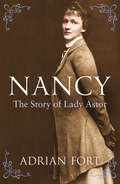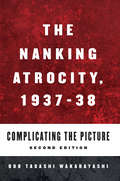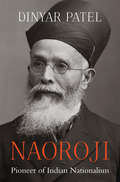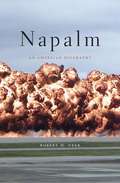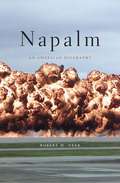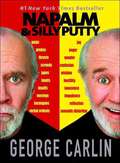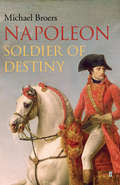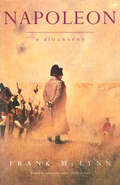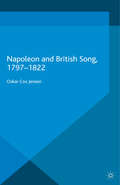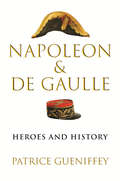- Table View
- List View
Namoluk Beyond The Reef: The Transformation Of A Micronesian Community
by Mac MarshallThis case study examines emigrants from Namoluk Atoll in the Eastern Caroline Islands of Micronesia, in the Western Pacific. Most members of the Namoluk community (chon Namoluk) do not currently live there - some 60% of them have moved to Chuuk, Guam, or the mainland US (such as Honolulu, Hawai'i or Eureka, California). The question is how (and why) those expatriates continue to think of themselves as chon Namoluk, and behave accordingly, despite being a far-flung network of people, with inevitable erosions of shared language and culture.
Namoluk Beyond The Reef: The Transformation Of A Micronesian Community (Westview Case Studies In Anthropology)
by Mac MarshallThis case study examines emigrants from Namoluk Atoll in the Eastern Caroline Islands of Micronesia, in the Western Pacific. Most members of the Namoluk community (chon Namoluk) do not currently live there - some 60% of them have moved to Chuuk, Guam, or the mainland US (such as Honolulu, Hawai'i or Eureka, California). The question is how (and why) those expatriates continue to think of themselves as chon Namoluk, and behave accordingly, despite being a far-flung network of people, with inevitable erosions of shared language and culture.
Nancy: The Story Of Lady Astor
by Adrian FortIn 1919, Nancy Astor became the first woman to take a seat in parliament.She was not what had been expected. Far from a virago who had suffered for the cause of female suffrage, she was already near the centre of the ruling society that had for so long resisted the political upheavals of the early twentieth century, having married into the family of one of the richest men in the world. She was not even British. She would prove to be a trailblazer and beacon for the generations of women who would follow her into Parliament.This new biography charts Nancy Astor's incredible story, from penury in the American South, to a lifestyle of the most immense riches, from the luxury of Edwardian England, through the 'Jazz Age', and on towards the Second World War: a world of great country estates, lavish town houses and the most sumptuous entertainments, peopled by the most famous and powerful names of the age. But hers was not only the life of power, glamour and easy charm: it was also defined by principles and bravery, by war and sacrifice, by love and bitter disputes. With glorious, page-turning brio, Adrian Fort has brought to life this restless, controversial American dynamo, an unforgettable woman who left a deep and lasting imprint on the political life of our nation.
The Nanjing Massacre: A Japanese Journalist Confronts Japan's National Shame
by Katsuichi Honda Frank Gibney Karen SandnessThis book is based on four visits to China between 1971 and 1989 by Honda Katsuichi, an investigative journalist for Asahi Shimbun. His aim is to show in pitiless detail the horrors of the Japanese Army's seizure and capture of Nanjing in December 1937. Unvarnished accounts of the testimony - Chinese victims and Japanese perpetrators - to the rape and slaughter are juxtaposed with public relations announcements of the Japanese Army as printed in various Japanese newspapers of the time. The bland announcements of triumphant victories stand in bitter contrast to the atrocities that actually took place on the scene. The story unfolds with horrible detail as we watch the triumphant progress of the Japanese army whose troops were bent on rape and killing in the so-called "heat of battle." Yet by recalling the testimony of Japanese soldiers and reporters who were on the scene, as well as reproducing dispatches by Japanese Army authorities at the time, Honda makes it clear that the atrocities were part of a studied effort directed by the Japanese high command to impress the Chinese people with the power of its army and the folly of resistance to it - the estimate of 300,000 killed in these "military operations" is no exaggeratoin. Honda has worked with other Japanese journalists and scholars who have attempted to reveal the truth of the Nanjing massacre, provoked by the efforts of right-wing Japanese, including, sadly, many government officials, to whitewash the whole incident, even to the point of contending that a "massacre" never happened. This gripping account of the atrocities and cover-up joins other exposes - Chinese and now German - in keeping alive the memory of this shameful event.
The Nanjing Massacre: A Japanese Journalist Confronts Japan's National Shame (Studies Of The Pacific Basin Institute)
by Katsuichi Honda Frank Gibney Karen SandnessThis book is based on four visits to China between 1971 and 1989 by Honda Katsuichi, an investigative journalist for Asahi Shimbun. His aim is to show in pitiless detail the horrors of the Japanese Army's seizure and capture of Nanjing in December 1937. Unvarnished accounts of the testimony - Chinese victims and Japanese perpetrators - to the rape and slaughter are juxtaposed with public relations announcements of the Japanese Army as printed in various Japanese newspapers of the time. The bland announcements of triumphant victories stand in bitter contrast to the atrocities that actually took place on the scene. The story unfolds with horrible detail as we watch the triumphant progress of the Japanese army whose troops were bent on rape and killing in the so-called "heat of battle." Yet by recalling the testimony of Japanese soldiers and reporters who were on the scene, as well as reproducing dispatches by Japanese Army authorities at the time, Honda makes it clear that the atrocities were part of a studied effort directed by the Japanese high command to impress the Chinese people with the power of its army and the folly of resistance to it - the estimate of 300,000 killed in these "military operations" is no exaggeratoin. Honda has worked with other Japanese journalists and scholars who have attempted to reveal the truth of the Nanjing massacre, provoked by the efforts of right-wing Japanese, including, sadly, many government officials, to whitewash the whole incident, even to the point of contending that a "massacre" never happened. This gripping account of the atrocities and cover-up joins other exposes - Chinese and now German - in keeping alive the memory of this shameful event.
The Nanking Atrocity, 1937-1938: Complicating the Picture
by Bob Tadashi WakabayashiFirst published in 2007, The Nanking Atrocity remains an essential resource for understanding the massacre committed by Japanese soldiers in Nanking, China during the winter of 1937-38. Through a series of deeply considered and empirically rigorous essays, it provides a far more complex and nuanced perspective than that found in works like Iris Chang’s bestselling The Rape of Nanking. It systematically reveals the flaws and exaggerations in Chang’s book while deflating the self-exculpatory narratives that persist in Japan even today. This second edition includes an extensive new introduction by the editor reflecting on the historiographical developments of the last decade, in advance of the 80th anniversary of the massacre.
The Nanny State Made Me: A Story of Britain and How to Save it
by Stuart Maconie'He is as funny as Bryson and as wise as Orwell' ObserverIt was the spirit of our finest hour, the backbone of our post-war greatness, and it promoted some of the boldest and most brilliant schemes this isle has ever produced: it was the Welfare State, and it made you and I. But now it's under threat, and we need to save it.In this timely and provocative book, Stuart Maconie tells Britain’s Welfare State story through his own history of growing up as a northern working class boy. What was so bad about properly funded hospitals, decent working conditions and affordable houses? And what was so wrong about student grants, free eye tests and council houses? And where did it all go so wrong? Stuart looks toward Britain’s future, making an emotional case for believing in more than profit and loss; and championing a just, fairer society.
Nano-Publics: Communicating Nanotechnology Applications, Risks, and Regulations
by Pat J. GehrkeThis book discusses the results and implications of a two-year public engagement program on nanotechnology. Led by eleven diverse civic groups across the United States, the program events covered a wide range of applications and sparked robust discussions concerning risk and regulation. Through computer-assisted qualitative data analysis, video recordings of the events were coded for expressed levels of knowledge, positive and negative audience responses, perceptions of risk, views on regulation, and speakers’ communication behaviors. These results add richness, nuance, and complexity to our perception of the public's understanding of nanotechnology, its support for regulation, and effective practices of science communication in the context of nanotechnology and other emerging technologies. Nano-Publics also offers further guidance for public engagement research, the regulation of emerging technologies, and potential science communication campaigns.
Nano-Publics: Communicating Nanotechnology Applications, Risks, and Regulations
by Pat J. GehrkeThis book discusses the results and implications of a two-year public engagement program on nanotechnology. Led by eleven diverse civic groups across the United States, the program events covered a wide range of applications and sparked robust discussions concerning risk and regulation. Through computer-assisted qualitative data analysis, video recordings of the events were coded for expressed levels of knowledge, positive and negative audience responses, perceptions of risk, views on regulation, and speakers’ communication behaviors. These results add richness, nuance, and complexity to our perception of the public's understanding of nanotechnology, its support for regulation, and effective practices of science communication in the context of nanotechnology and other emerging technologies. Nano-Publics also offers further guidance for public engagement research, the regulation of emerging technologies, and potential science communication campaigns.
Nanopesticides: From Research and Development to Mechanisms of Action and Sustainable Use in Agriculture
by Renato Grillo Leonardo F. Fraceto Vera Lucia S.S. de Castro Daiana Ávila Halley Caixeta Oliveira Renata LimaThis book explores the development of nanopesticides and tests of their biological activity against target organisms. It also covers the effects of nanopesticides in the aquatic and terrestrial environments, along with related subjects including fate, behaviour, mechanisms of action and toxicity. Moreover, the book discusses the potential risks of nanopesticides for non-target organisms, as well as regulatory issues and future perspectives.
Nanotechnologies, Hazards and Resource Efficiency: A Three-Tiered Approach to Assessing the Implications of Nanotechnology and Influencing its Development
by Michael Steinfeldt Arnim Gleich Ulrich Petschow Rüdiger HaumTaking as its subject matter one aspect of the hugely important subject of nanotechnology, this book demonstrates that the application of nanotechnology in industry can result in increased eco-efficiency and other environmental gains. It also shows what needs to be done from the point of view of scientists, engineers and science policy makers to guide future development in nanotechnology towards sustainability.
Nanotechnology for Chemical and Biological Defense
by Margaret KosalNew and unpredicted technologies are emerging at an unprecedented pace around the world. Communication of those new discoveries is occurring faster than ever, meaning that the unique ownership of a piece of new technology is no longer a sufficient position, if not impossible. In today’s world, recognition of the potential applications of a technology and a sense of purpose in exploiting it are far more important than simply having access to it. Technological surprise has and will continue to take many forms. A plethora of new technologies are under development for peaceful means but may have un- tended security consequences and will certainly require innovative counterme- ures. A relevant example is the tremendous development in biotechnology that has occurred since the advent of recombinant DNA and tissue culture-based processes in the 1970s. If US government agencies and the defense and academic commu- ties had more clearly recognized the potential for biotechnology to affect fun- mental security and warfighting doctrines 20 years ago, the situation today could be very different. Defense against chemical and biological weapons – from both states and nonstate actors – currently presents a threat that is difficult to predict and for which traditional solutions are increasingly less effective. Nanotechnology has emerged as a well-funded discipline that, like biote- nology, carries the potential for groundbreaking applications and the potential for unpredictable harm. The world is likely 20 years away from the full impact of the nanotechnology on defensive capabilities.
Nanotechnology for Defence Applications
by Narendra Kumar Ambesh DixitThis book examines the application of nanoscience and nanotechnology in military defence strategies. Both historical and current perspectives on military technologies are discussed. The book provides comprehensive details on current trends in the application of nanotechnology to ground, air, and naval specializations. Furthermore, nanotechnology-enabled high energy explosives and propellants, chemical, biological, radiation, and nuclear threats and their detection/protection, and camouflage and stealth for signature management of military targets in multispectral wavelength signals are analyzed. The book also covers nanotechnology-enabled armor and platforms, which may serve as lightweight and high mechanical strength options in contrast to conventional systems. Finally, the book also emphasizes future military applications of nanotechnology and its integration into ‘smart’ materials.Provides comprehensive details on trends in the application of nanotechnology to ground, air, and naval defence systems;Examines the application of nanoscience and nanotechnology in military defence strategies;Offers pathways and research avenues for development of nanotechnology and materials applications in military capacities.
Nanotechnology, Governance, and Knowledge Networks in the Global South
by Marcela Suárez EstradaThe seemingly unlimited technological potential of nanotechnology brings with it new practices of governance, networking, and exercising power and agency. Focusing on scholars in the Global South, this text covers nanotechnology discourses, imaginaries, and materialities as they circulate and interact within governance knowledge networks. Rather than adapt their actions to existing governance mechanisms and science, technology, and innovation policy, scientists use the imaginary of nanotechnology to create new symbolic and material incentives, thus shaping its governance. By tracing the constantly shifting asymmetries of knowledge and power, the book offers fresh insights into the dynamics of knowledge networks.
Nanotechnology, Governance, and Knowledge Networks in the Global South
by Marcela Suárez EstradaThe seemingly unlimited technological potential of nanotechnology brings with it new practices of governance, networking, and exercising power and agency. Focusing on scholars in the Global South, this text covers nanotechnology discourses, imaginaries, and materialities as they circulate and interact within governance knowledge networks. Rather than adapt their actions to existing governance mechanisms and science, technology, and innovation policy, scientists use the imaginary of nanotechnology to create new symbolic and material incentives, thus shaping its governance. By tracing the constantly shifting asymmetries of knowledge and power, the book offers fresh insights into the dynamics of knowledge networks.
Nanotechnology in Civil Infrastructure: A Paradigm Shift
by Kasthurirangan Gopalakrishnan Bjorn Birgisson Peter Taylor Nii O. Attoh-OkineNanotechnology in Civil Infrastructure is a state-of-the art reference source describing the latest developments in nano-engineering and nano-modification of construction materials to improve the bulk properties, development of sustainable, intelligent, and smart concrete materials through the integration of nanotechnology based self-sensing and self-powered materials and cyber infrastructure technologies, review of nanotechnology applications in pavement engineering, development of novel, cost-effective, high-performance and long-lasting concrete products and processes through nanotechnology-based innovative processing of cement and cement paste, and advanced nanoscience modeling, visualization, and measurement systems for characterizing and testing civil infrastructure materials at the nano-scale. Researchers, practitioners, undergraduate and graduate students engaged in nanotechnology related research will find this book very useful.
Nanotechnology, Risk and Communication
by A. Anderson A. Petersen C. Wilkinson S. AllanDrawing together insights from media studies, sociology and science and technology studies, this book is one of the first major studies of media coverage, policy debates and public perceptions of nanotechnologies, and makes a fascinating and timely contribution to debates about the public communication of science.
Naoroji: Pioneer of Indian Nationalism
by Dinyar PatelThe definitive biography of Dadabhai Naoroji, the nineteenth-century activist who founded the Indian National Congress, was the first British MP of Indian origin, and inspired Gandhi and Nehru. Mahatma Gandhi called Dadabhai Naoroji the “father of the nation,” a title that today is reserved for Gandhi himself. Dinyar Patel examines the extraordinary life of this foundational figure in India’s modern political history, a devastating critic of British colonialism who served in Parliament as the first-ever Indian MP, forged ties with anti-imperialists around the world, and established self-rule or swaraj as India’s objective. Naoroji’s political career evolved in three distinct phases. He began as the activist who formulated the “drain of wealth” theory, which held the British Raj responsible for India’s crippling poverty and devastating famines. His ideas upended conventional wisdom holding that colonialism was beneficial for Indian subjects and put a generation of imperial officials on the defensive. Next, he attempted to influence the British Parliament to institute political reforms. He immersed himself in British politics, forging links with socialists, Irish home rulers, suffragists, and critics of empire. With these allies, Naoroji clinched his landmark election to the House of Commons in 1892, an event noticed by colonial subjects around the world. Finally, in his twilight years he grew disillusioned with parliamentary politics and became more radical. He strengthened his ties with British and European socialists, reached out to American anti-imperialists and Progressives, and fully enunciated his demand for swaraj. Only self-rule, he declared, could remedy the economic ills brought about by British control in India. Naoroji is the first comprehensive study of the most significant Indian nationalist leader before Gandhi.
Napalm: An American Biography
by Robert M. NeerNapalm was invented on Valentine’s Day 1942 at a secret Harvard war research laboratory. It created an inferno that killed over 87,500 people in Tokyo—more than died in the atomic explosions at Hiroshima or Nagasaki—and went on to incinerate 64 Japanese cities. The Bomb got the press, but napalm did the work. Robert Neer offers the first history.
Napalm: An American Biography
by Robert M. NeerNapalm was invented on Valentine’s Day 1942 at a secret Harvard war research laboratory. It created an inferno that killed over 87,500 people in Tokyo—more than died in the atomic explosions at Hiroshima or Nagasaki—and went on to incinerate 64 Japanese cities. The Bomb got the press, but napalm did the work. Robert Neer offers the first history.
Napalm & Silly Putty
by George CarlinA hilarious new collection of razor-sharp observations from the New York Times bestselling author of Brain Droppings. Few comics make the transition from stage to page as smoothly or successfully as George Carlin. Brain Droppings spent a total of 40 weeks on the New York Times bestseller list, and this new one is certain to tickle even more ribs (and rattle a few more cages) with its characteristically ironic take on life's annoying universal truths. In Napalm & Silly Putty, Carlin doesn't steer clear of the tough issues, preferring instead to look life boldly in the eye to pose the questions few dare to ask:How can it be a spy satellite if they announce on TV that it's a spy satellite?Why do they bother saying "raw sewage"? Do some people cook that stuff?In the expression "topsy-turvy," what exactly is meant by "turvy"? And he makes some startling observations, including:Most people with low self-esteem have earned it.Guys don't seem to be called "Lefty" anymore.Most people don't know what they're doing, and a lot of them are really good at it. Carlin also waxes wickedly philosophical on all sorts of subjects, including:KIDS--They're not all cute. In fact, if you look at them closely, some of them are rather unpleasant looking. And a lot of them don't smell too good either.DEATH ROW--If you're condemned to die they have to give you one last meal of your own request. What is that all about? A group of people plan to kill you, so they want you to eat something you like? Add to the mix "The Ten Most Embarrassing Songs of All Time," "The 20th Century Hostility Scoreboard," and "People I Can Do Without," and you have an irresistibly insouciant assortment of musings, questions, assertions, and assumptions guaranteed to please the millions of fans waiting for the next Carlin collection--and the millions more waiting to discover this comic genius.
Napoleon: Soldier of Destiny
by Michael BroersThis is the first life of Napoleon, in any language, that makes full use of the new version of his Correspondence compiled by the Fondation Napoléon in Paris to replace the sanitized compilation made under the Second French Empire as a propaganda exercise by his nephew, Napoleon III. All previous lives of Napoleon have relied more on the memoirs of others than on his own uncensored words. Michael Broers' biography draws on the thoughts of Napoleon himself as his incomparable life unfolded. It reveals a man of intense emotion, but also of iron self-discipline; of acute intelligence and immeasurable energy. Tracing his life from its dangerous Corsican roots, through his rejection of his early identity, and the dangerous military encounters of his early career, it tells the story of the sheer determination, ruthlessness and careful calculation that won him the precarious mastery of Europe by 1807. After the epic battles of Austerlitz, Jena and Friedland, France was the dominant land power on the continent.Here is the first life in which Napoleon speaks in his own voice, but not always as he wanted the world to hear him.
Napoleon: A Biography
by Frank McLynnNapoleon Bonaparte's character and achievements have always divided critics and commentators. In this compelling new biography Frank McLynn draws on the most recent scholarship and throws a brilliant light on this most paradoxical of men - as military leader, lover and emperor. Tracing Napoleon's extraordinary career, Mc Lynn examines the Promethean legend from the Corsican roots, through the years of the French Revolution and the military triumphs, to the coronation in 1804 and ultimate defeat and imprisonment. Napoleon the man emerges as an even more fascinating character than previously imagined, and McLynn brilliantly reveals the extent to which he was both existential hero and plaything of Fate; mathematician and mystic; intellectual giant and moral pygmy; Great Man and deeply flawed human being.
Napoleon and British Song, 1797-1822 (War, Culture and Society, 1750-1850)
by Oskar Cox JensenThis study offers a radical reassessment of a crucial period of political and cultural history. By looking at some 400 songs, many of which are made available to hear, and at their writers, singers, and audiences, it questions both our relationship with song, and ordinary Britons' relationship with Napoleon, the war, and the idea of Britain itself.
Napoleon and de Gaulle: Heroes and History
by Patrice GueniffeyOne of France’s most famous historians compares two exemplars of political and military leadership to make the unfashionable case that individuals, for better and worse, matter in history. Historians have taught us that the past is not just a tale of heroes and wars. The anonymous millions matter and are active agents of change. But in democratizing history, we have lost track of the outsized role that individual will and charisma can play in shaping the world, especially in moments of extreme tumult. Patrice Gueniffey provides a compelling reminder in this powerful dual biography of two transformative leaders, Napoleon Bonaparte and Charles de Gaulle. Both became national figures at times of crisis and war. They were hailed as saviors and were eager to embrace the label. They were also animated by quests for personal and national greatness, by the desire to raise France above itself and lead it on a mission to enlighten the world. Both united an embattled nation, returned it to dignity, and left a permanent political legacy—in Napoleon’s case, a form of administration and a body of civil law; in de Gaulle’s case, new political institutions. Gueniffey compares Napoleon’s and de Gaulle’s journeys to power; their methods; their ideas and writings, notably about war; and their postmortem reputations. He also contrasts their weaknesses: Napoleon’s limitless ambitions and appetite for war and de Gaulle’s capacity for cruelty, manifested most clearly in Algeria. They were men of genuine talent and achievement, with flaws almost as pronounced as their strengths. As many nations, not least France, struggle to find their soul in a rapidly changing world, Gueniffey shows us what a difference an extraordinary leader can make.

